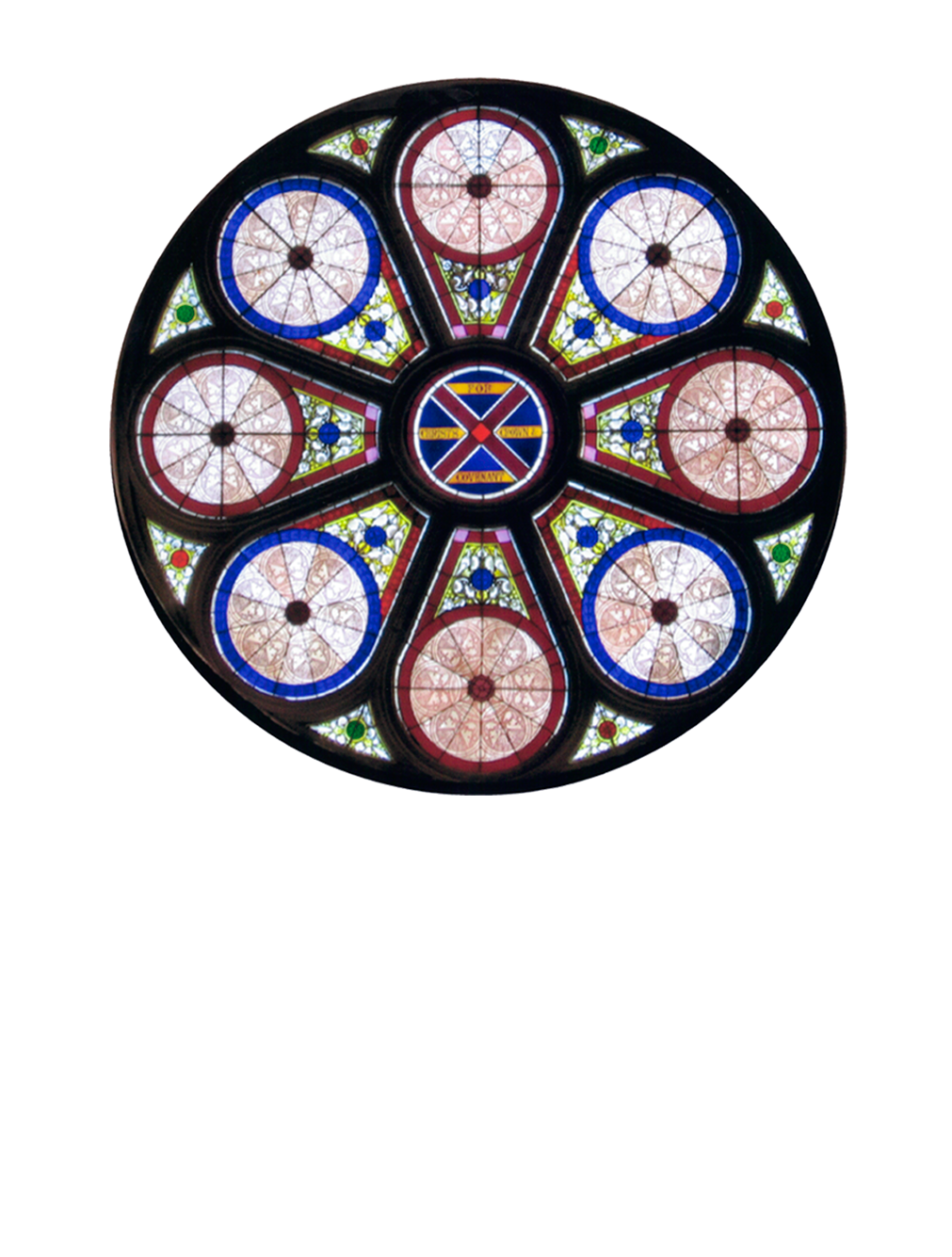1. The Lamb with Banner – The North Wall
 Throughout the Bible, Jesus is often symbolized as the Lamb of God: from Old Testament prophecies, to John the Baptist’s introduction of Jesus to his disciples, to St John’s picture of Jesus in the book of Revelation. As such, Jesus is portrayed as that perfect Sacrifice for our sins — the One who could atone for our sinful condition in ways that we never could. However, the church has always confessed that Jesus’ sacrificial death on the Cross was not a sign of His weakness or failure, but a sign of His victory . . . His victory over death, His victory over sin, His victory over Satan. The symbol that the Church historically developed to represent this was a lamb carrying a banner, just as conquering armies of centuries ago carried banners to signify a great military conquest. Throughout the Bible, Jesus is often symbolized as the Lamb of God: from Old Testament prophecies, to John the Baptist’s introduction of Jesus to his disciples, to St John’s picture of Jesus in the book of Revelation. As such, Jesus is portrayed as that perfect Sacrifice for our sins — the One who could atone for our sinful condition in ways that we never could. However, the church has always confessed that Jesus’ sacrificial death on the Cross was not a sign of His weakness or failure, but a sign of His victory . . . His victory over death, His victory over sin, His victory over Satan. The symbol that the Church historically developed to represent this was a lamb carrying a banner, just as conquering armies of centuries ago carried banners to signify a great military conquest.
|
|
2. The Sheaf of Wheat
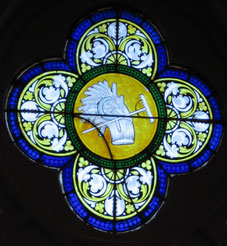 Wheat reminds us of two different things in our faith, as it has been used in Scripture and in tradition. First, wheat has been a symbol of our growth as God’s children. God is the great farmer/gardener who lovingly and carefully scatters seed, tending it so that it grows and bears a fruitful crop. Biblically, this “seed” is us, whom God plants, longing for us to bear lives that are filled with the “fruits” of good deeds and faithful witness to Christ. Second, wheat reminds us that Jesus is the Bread of Life ~ that sustenance which we need to live and grow. We are reminded of this most acutely when we take the bread during the Sacrament of Holy Communion. Wheat reminds us of two different things in our faith, as it has been used in Scripture and in tradition. First, wheat has been a symbol of our growth as God’s children. God is the great farmer/gardener who lovingly and carefully scatters seed, tending it so that it grows and bears a fruitful crop. Biblically, this “seed” is us, whom God plants, longing for us to bear lives that are filled with the “fruits” of good deeds and faithful witness to Christ. Second, wheat reminds us that Jesus is the Bread of Life ~ that sustenance which we need to live and grow. We are reminded of this most acutely when we take the bread during the Sacrament of Holy Communion.
|
3. Cross and Crown
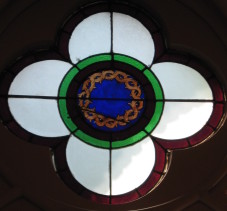 Like the symbol of the Lamb with banner, this ancient symbol of a wooden cross surrounded by a crown symbolizes Christ’s victory through His death on our behalf. Because of Christ’s faithful obedience to God ~ because He chose to go through with what He knew needed to be accomplished in God’s plan ~ Jesus became our conquering hero, our Ruler, our Monarch. Rather than the cross being a sign of failure, the cross of Christ is a sign of crowning victory. Like the symbol of the Lamb with banner, this ancient symbol of a wooden cross surrounded by a crown symbolizes Christ’s victory through His death on our behalf. Because of Christ’s faithful obedience to God ~ because He chose to go through with what He knew needed to be accomplished in God’s plan ~ Jesus became our conquering hero, our Ruler, our Monarch. Rather than the cross being a sign of failure, the cross of Christ is a sign of crowning victory.
|
|
4. Alpha and Omega
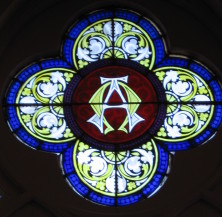 These two letters of the Greek alphabet, superimposed upon one another, are what St. John, in the New Test- ament book of Revelation, said Jesus was like. What did he mean by that? These two Greek letters are the first and last letters of their alphabet. By saying that Jesus is the Alpha and Omega, it is like saying, using letters of our alphabet, that Jesus is the “A” and the “Z” of life. In other words, Jesus is both the beginning and the end of our lives. . .our lives are lived within the context of Christ’s living presence. There is nowhere in life we can journey therefore, where Jesus Christ is not already present with us! These two letters of the Greek alphabet, superimposed upon one another, are what St. John, in the New Test- ament book of Revelation, said Jesus was like. What did he mean by that? These two Greek letters are the first and last letters of their alphabet. By saying that Jesus is the Alpha and Omega, it is like saying, using letters of our alphabet, that Jesus is the “A” and the “Z” of life. In other words, Jesus is both the beginning and the end of our lives. . .our lives are lived within the context of Christ’s living presence. There is nowhere in life we can journey therefore, where Jesus Christ is not already present with us!
|
5. The Open Bible
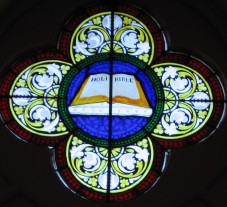 The Bible has always been the bedrock foundation of faith and life for us Presbyterians. The cry of the 16th century reformers was, “by Scripture alone.” That was their way of saying what we still believe today ~ namely, that whatever situations we face in our lives, whatever controversies and debates we might have in the Church, whatever guidance and comfort we need, we go to the Bible! The Bible is a living book. And we Presbyterians believe that, just as God the Holy Spirit inspired the authors and editors of Holy Scripture, so God the Holy Spirit continues to come to us today, to help us and guide us as we try to discern God’s work in our lives, in our world, in our church. The Bible has always been the bedrock foundation of faith and life for us Presbyterians. The cry of the 16th century reformers was, “by Scripture alone.” That was their way of saying what we still believe today ~ namely, that whatever situations we face in our lives, whatever controversies and debates we might have in the Church, whatever guidance and comfort we need, we go to the Bible! The Bible is a living book. And we Presbyterians believe that, just as God the Holy Spirit inspired the authors and editors of Holy Scripture, so God the Holy Spirit continues to come to us today, to help us and guide us as we try to discern God’s work in our lives, in our world, in our church.
|
|
6. Crown of Thorns – The South Wall
 As Scripture tells us, Jesus was “crowned” by the Roman soldiers with a ring of thorn branches, intertwined and forced down upon His head like a crown. Those soldiers thought they were ridiculing Christ, who was being crucified, among other reasons, because He was a “king”. This ancient symbol reminds us, not just of Jesus’ rule in our lives as King of kings, but, more vividly in this symbol, of the terrible suffering and agony that Jesus went through in His Passion. . .in the hours before His Crucifixion. Our salvation ~ that is, our reconciliation with God, made possible by Christ’s death and resurrection ~ did not come cheaply. As the Bible says, we were “bought with a price,” and that price was Christ’s suffering. This crown of thorns reminds us of what Christ voluntarily went through on our behalf. As Scripture tells us, Jesus was “crowned” by the Roman soldiers with a ring of thorn branches, intertwined and forced down upon His head like a crown. Those soldiers thought they were ridiculing Christ, who was being crucified, among other reasons, because He was a “king”. This ancient symbol reminds us, not just of Jesus’ rule in our lives as King of kings, but, more vividly in this symbol, of the terrible suffering and agony that Jesus went through in His Passion. . .in the hours before His Crucifixion. Our salvation ~ that is, our reconciliation with God, made possible by Christ’s death and resurrection ~ did not come cheaply. As the Bible says, we were “bought with a price,” and that price was Christ’s suffering. This crown of thorns reminds us of what Christ voluntarily went through on our behalf.
|
7. IHS
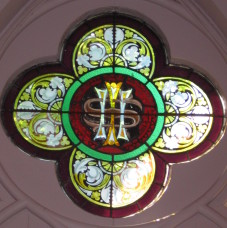 Contrary to what this window looks like ~ sort of a fancy “dollar sign” ~ this symbol has nothing to do with money! This symbol, in actuality, is three Greek letters superimposed upon one another. They are the first three letters, in Greek, of the name, “Jesus,” and they have long been used in the Church to remind people that it is Jesus who is the center of our faith and life. It is significant to note, here, that the name, Jesus, in Hebrew, means “God saves,” or “God is salvation.” What a fitting name for our Lord and Savior! Contrary to what this window looks like ~ sort of a fancy “dollar sign” ~ this symbol has nothing to do with money! This symbol, in actuality, is three Greek letters superimposed upon one another. They are the first three letters, in Greek, of the name, “Jesus,” and they have long been used in the Church to remind people that it is Jesus who is the center of our faith and life. It is significant to note, here, that the name, Jesus, in Hebrew, means “God saves,” or “God is salvation.” What a fitting name for our Lord and Savior!
|
|
8. Grapes and Chalice
 The grapes — and their product wine — have long been used in the Bible as a powerful symbol. In the Old Testament sacrament of the Passover meal, wine was used (and is still used today in Jewish homes) as a symbol to remind the people of the blood that was spread on the doorposts and lintels of their homes, which caused the “angel of death” in the 10th plague in Egypt to “pass over” their homes, thus sparing them from God’s horrible judgment. In the New Testament, Jesus applied that powerful symbol to His own death upon the cross when He said to His disciples at the last Supper, “This cup which is poured out for you is the new covenant in my blood.” (Luke 22:20) When we take the cup during the celebration of the Sacrament of Holy Communion, we are reminded that we are the recipients of God’s new covenant with us, given to us freely by Christ’s death. The grapes — and their product wine — have long been used in the Bible as a powerful symbol. In the Old Testament sacrament of the Passover meal, wine was used (and is still used today in Jewish homes) as a symbol to remind the people of the blood that was spread on the doorposts and lintels of their homes, which caused the “angel of death” in the 10th plague in Egypt to “pass over” their homes, thus sparing them from God’s horrible judgment. In the New Testament, Jesus applied that powerful symbol to His own death upon the cross when He said to His disciples at the last Supper, “This cup which is poured out for you is the new covenant in my blood.” (Luke 22:20) When we take the cup during the celebration of the Sacrament of Holy Communion, we are reminded that we are the recipients of God’s new covenant with us, given to us freely by Christ’s death.
|
9. The Dove
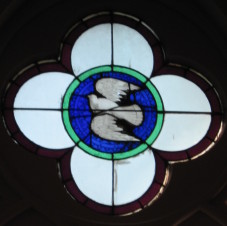 The dove is used two significant times in the Bible. First, Noah sent a dove out from the ark, to see if the flood waters had receded enough for dry land to appear. You will remember that the dove brought back to Noah an olive branch, showing that dry land indeed had appeared, symbolizing that God had made peace with the creation once again. In the New Testament, a dove appeared after Jesus had been baptized in the Jordan River by John the Baptist, symbolizing the descent of the Holy Spirit, uniting God the Father and God the Son. This symbol in this window reminds us that God continues to come to us by the Holy Spirit, to renew God’s covenant of love and peace with us. The dove is used two significant times in the Bible. First, Noah sent a dove out from the ark, to see if the flood waters had receded enough for dry land to appear. You will remember that the dove brought back to Noah an olive branch, showing that dry land indeed had appeared, symbolizing that God had made peace with the creation once again. In the New Testament, a dove appeared after Jesus had been baptized in the Jordan River by John the Baptist, symbolizing the descent of the Holy Spirit, uniting God the Father and God the Son. This symbol in this window reminds us that God continues to come to us by the Holy Spirit, to renew God’s covenant of love and peace with us.
|
|
10. Anchor
 In Hebrews 6:19, the author of that New Testament book talks about God’s unchangeable covenant of love, which gives us an unshakable hope in God, and which thereby serves us as “a sure and steadfast anchor of the soul.” This ancient symbol, used to hold shops fast against whatever storms and winds they might encounter, reminds us that God, in and through Jesus Christ, is the dependable Anchor upon which we can rest our lives. In Hebrews 6:19, the author of that New Testament book talks about God’s unchangeable covenant of love, which gives us an unshakable hope in God, and which thereby serves us as “a sure and steadfast anchor of the soul.” This ancient symbol, used to hold shops fast against whatever storms and winds they might encounter, reminds us that God, in and through Jesus Christ, is the dependable Anchor upon which we can rest our lives.
Even though we cannot always predict or control the events of our lives, we can be assured that God is always present with us, to guide us through the “storms”that steadily come our way in this life. Thus our lives are “anchored” in God’s saving and redeeming love!
|
